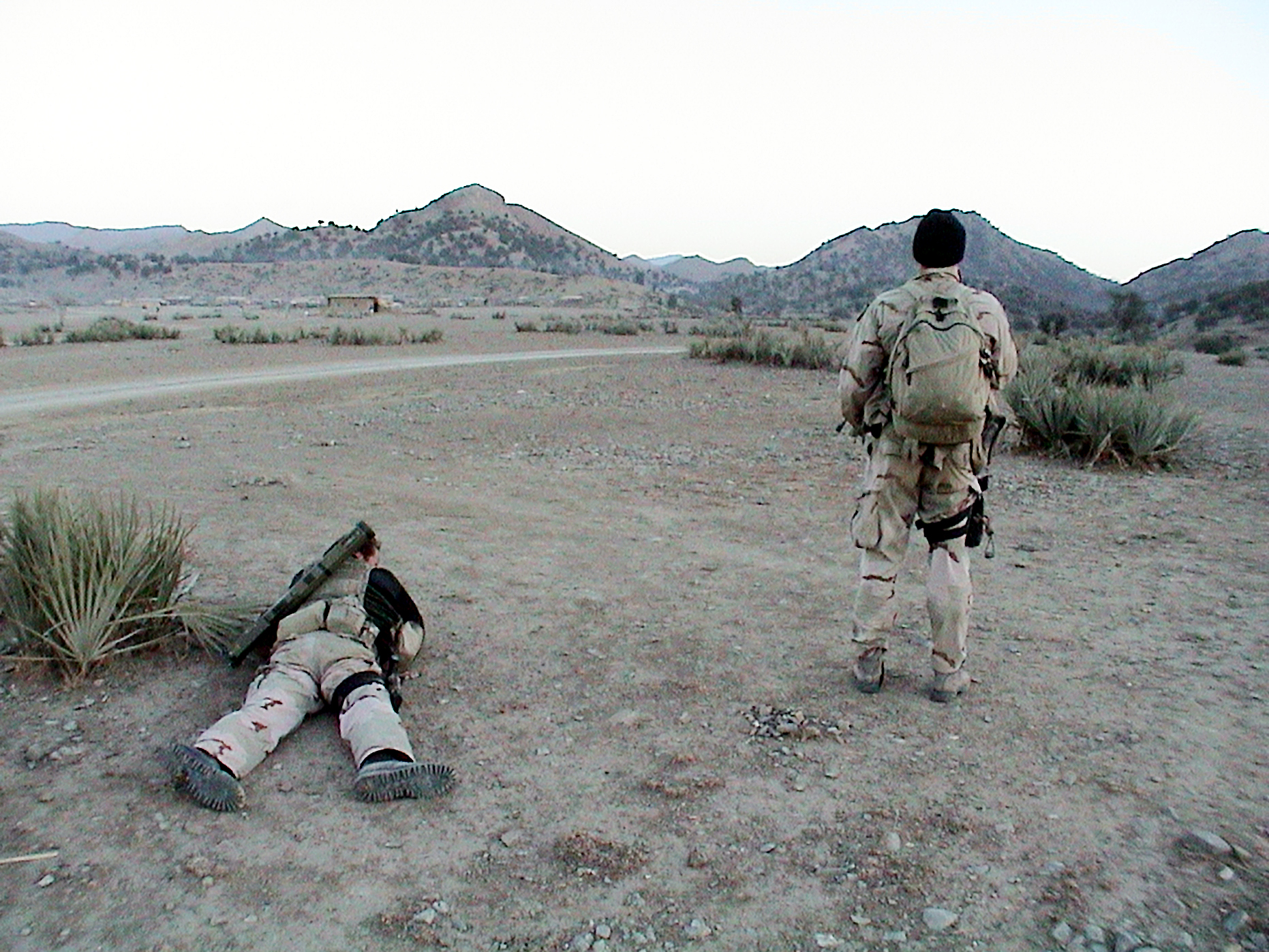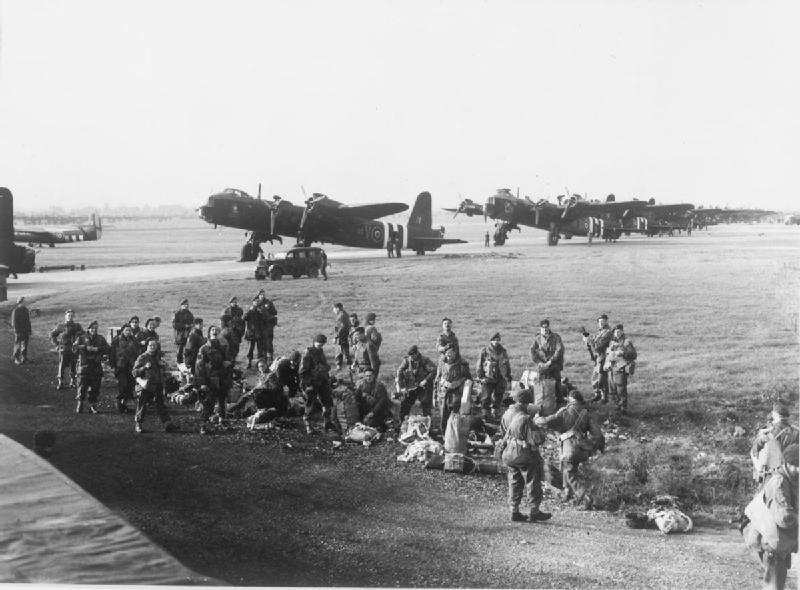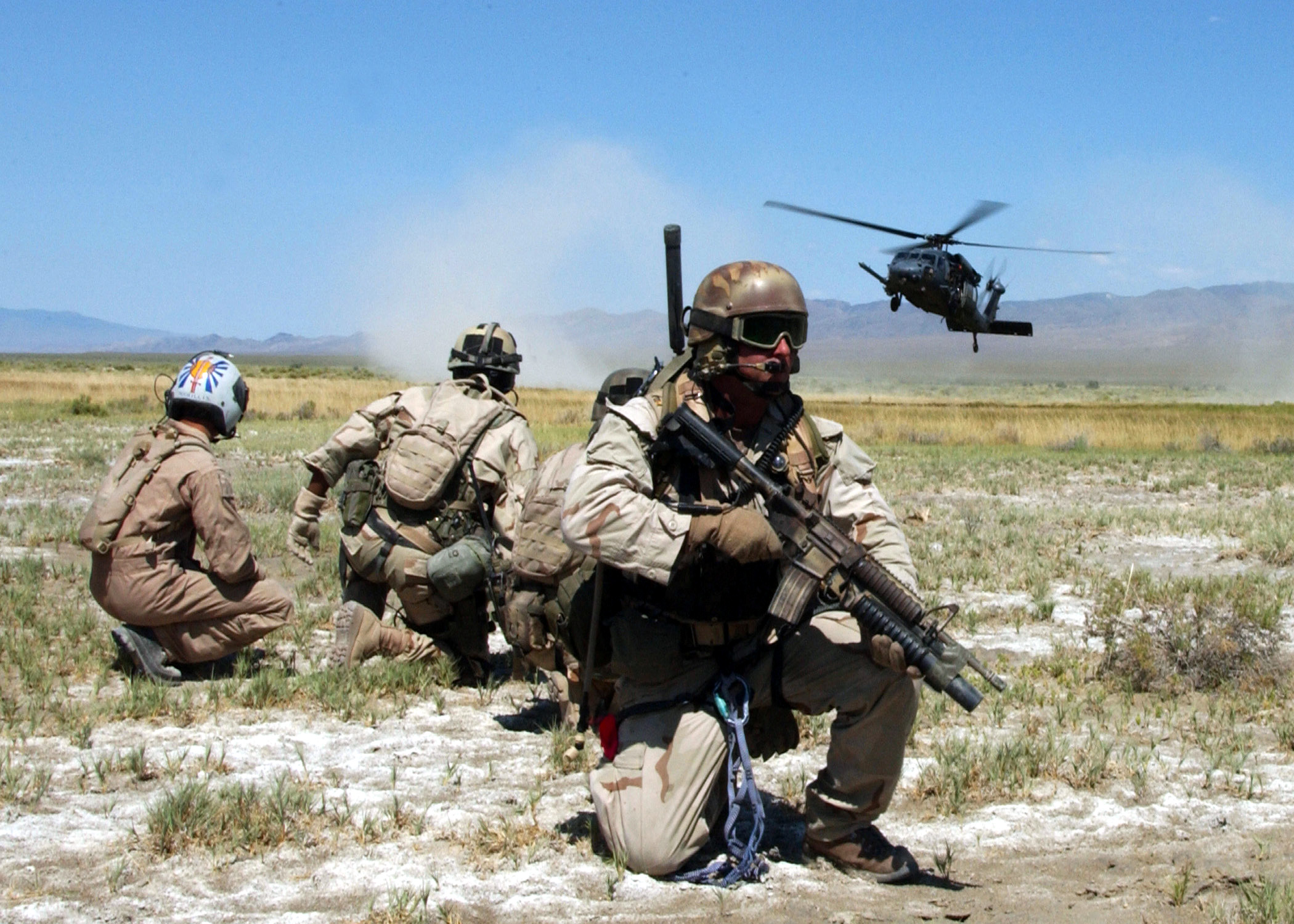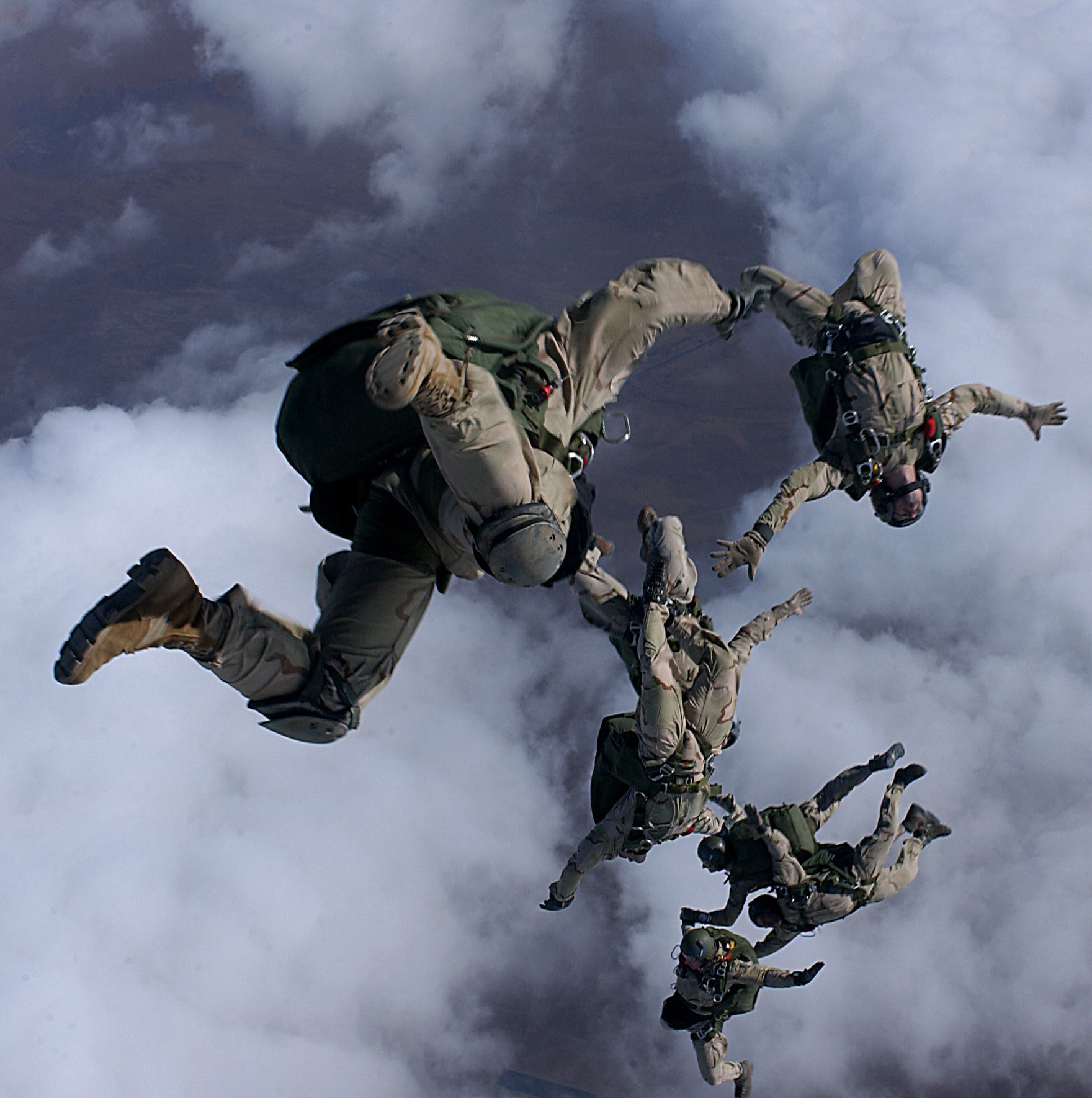|
Namibian Special Forces
The Namibian Special Forces is a special operations command of the Namibian Defence Force responsible for special forces and special operations capable units. The command consists of Army commandos, Army Airborne paratroopers and the Marine Corps amphibious special operations unit. The Army commandos specialize in airborne and land borne insertion while the Marine Corps amphibious special operations unit specialize in small-unit maritime operations that originate from a river, ocean, swamp and delta. The army units receive training assistance from former South African Special Forces (Recces) and the marine corps from the Brazilian Marine Corps. The units regularly participate in Southern African Development Community (SADC) special forces exercises. Role The roles vary according to the unit. The Airborne Parachute Battalion role is to be dropped to an objective via static line parachuting. The Pathfinder unit is a Special Reconnaissance unit of the Parachute Battalion, its role is ... [...More Info...] [...Related Items...] OR: [Wikipedia] [Google] [Baidu] |
Special Operations
Special operations (S.O.) are military activities conducted, according to NATO, by "specially designated, organized, selected, trained, and equipped forces using unconventional techniques and modes of employment". Special operations may include reconnaissance, unconventional warfare, and counter-terrorism actions, and are typically conducted by small groups of highly-trained personnel, emphasizing sufficiency, stealth, speed, and tactical coordination, commonly known as " special forces". History Australia In World War II following advice from the British, Australia began raising special forces. The first units to be formed were independent companies, which began training at Wilson's Promontory in Victoria in early 1941 under the tutelage of British instructors. With an establishment of 17 officers and 256 men, the independent companies were trained as "stay behind" forces, a role that they were later employed in against the Japanese in the South West Pacific Area during 1942†... [...More Info...] [...Related Items...] OR: [Wikipedia] [Google] [Baidu] |
Special Reconnaissance
Special reconnaissance (SR) or Recon Team is conducted by small units of highly trained military personnel, usually from special forces units or military intelligence organizations, who operate behind enemy lines, avoiding direct combat and detection by the enemy. As a role, SR is distinct from commando operations, but both are often carried out by the same units. The SR role frequently includes covert direction of airstrikes and indirect fires, in areas deep behind enemy lines, placement of remotely monitored sensors, and preparations for other special forces. Like other special forces, SR units may also carry out direct action and unconventional warfare, including guerrilla operations. In intelligence terms, SR is a human intelligence (HUMINT) collection discipline. Its operational control is likely to be inside a compartmented cell of the HUMINT, or possibly the operations, staff functions. Since such personnel are trained for intelligence collection as well as other missions, ... [...More Info...] [...Related Items...] OR: [Wikipedia] [Google] [Baidu] |
Regiment
A regiment is a military unit. Its role and size varies markedly, depending on the country, service and/or a specialisation. In Medieval Europe, the term "regiment" denoted any large body of front-line soldiers, recruited or conscripted in one geographical area, by a leader who was often also the feudal lord ''in capite'' of the soldiers. Lesser barons of knightly rank could be expected to muster or hire a company or battalion from their manorial estate. By the end of the 17th century, infantry regiments in most European armies were permanent units, with approximately 800 men and commanded by a colonel. Definitions During the modern era, the word "regiment" – much like "corps" – may have two somewhat divergent meanings, which refer to two distinct roles: # a front-line military formation; or # an administrative or ceremonial unit. In many armies, the first role has been assumed by independent battalions, battlegroups, task forces, brigades and other, similarly s ... [...More Info...] [...Related Items...] OR: [Wikipedia] [Google] [Baidu] |
Commando
Royal Marines from 40 Commando on patrol in the Sangin">40_Commando.html" ;"title="Royal Marines from 40 Commando">Royal Marines from 40 Commando on patrol in the Sangin area of Afghanistan are pictured A commando is a combatant, or operative of an elite light infantry or special operations force, specially trained for carrying out raids and operating in small teams behind enemy lines. Originally "a commando" was a type of combat unit, as opposed to an individual in that unit. In other languages, ''commando'' and ''kommando'' denote a "command", including the sense of a military or an elite special operations unit. In the militaries and governments of most countries, commandos are distinctive in that they specialize in unconventional assault on high-value targets. In English, to distinguish between an individual commando and a commando unit, the unit is occasionally capitalized. Etymology From an ancient lingual perspective the term commando derives from Latin ''commen ... [...More Info...] [...Related Items...] OR: [Wikipedia] [Google] [Baidu] |
Pathfinder (military)
In military organizations, a pathfinder is a specialized soldier inserted or dropped into place in order to set up and operate drop zones, pickup zones, and helicopter landing sites for airborne operations, air resupply operations, or other air operations in support of the ground unit commander. Pathfinders first appeared in World War II, where they served with distinction, and continue to serve an important role in today's modern armed forces, providing commanders with the option of flexibly employing air assets. History United Kingdom During the Second World War small groups of parachute soldiers were formed into pathfinder units, to parachute ahead of the main force. Their tasks were to mark the drop zones (DZ) or landing zones (LZ), set up radio beacons as a guide for the aircraft carrying the main force and to clear and protect the area as the main force arrived. The units were formed into two companies to work with the two British airborne divisions created during th ... [...More Info...] [...Related Items...] OR: [Wikipedia] [Google] [Baidu] |
Parachute
A parachute is a device used to slow the motion of an object through an atmosphere by creating drag or, in a ram-air parachute, aerodynamic lift. A major application is to support people, for recreation or as a safety device for aviators, who can exit from an aircraft at height and descend safely to earth. A parachute is usually made of a light, strong fabric. Early parachutes were made of silk. The most common fabric today is nylon. A parachute's canopy is typically dome-shaped, but some are rectangles, inverted domes, and other shapes. A variety of loads are attached to parachutes, including people, food, equipment, space capsules, and bombs. History Middle Ages In 852, in Córdoba, Spain, the Moorish man Armen Firman attempted unsuccessfully to fly by jumping from a tower while wearing a large cloak. It was recorded that "there was enough air in the folds of his cloak to prevent great injury when he reached the ground." Early Renaissance The earliest evidence f ... [...More Info...] [...Related Items...] OR: [Wikipedia] [Google] [Baidu] |
Covert Operation
A covert operation is a military operation intended to conceal the identity of (or allow plausible deniability by) the party that instigated the operation. Covert operations should not be confused with clandestine operations, which are performed in secret and meant to stay secret. Covert operations aim to secretly fulfill their mission objectives without anyone knowing who sponsored or carried out the operation, or in some cases, without anyone knowing that the operation has even occurred. Impact According to a 2018 study by University of Chicago political scientist Austin Carson, covert operations may have the beneficial effect of preventing escalation of disputes into full-blown wars. He argues that keeping military operations secret can limit escalation dynamics, as well as insulate leaders from domestic pressures while simultaneously allowing them communicating their interest to the adversary in keeping a war contained. He finds that covert operations are frequently detec ... [...More Info...] [...Related Items...] OR: [Wikipedia] [Google] [Baidu] |
Combat Search And Rescue
Combat search and rescue (CSAR) are search and rescue operations that are carried out during war that are within or near combat zones. A CSAR mission may be carried out by a task force of helicopters, ground-attack aircraft, aerial refueling tankers and an airborne command post. The USAF HC-130, which was introduced in 1965, has served in the latter two roles. History The First World War was the background for the development of early combat search and rescue doctrine, especially in the more fluid theaters of war in the Balkans and the Middle East. In the opening fluid stages of the First World War the Royal Navy Air Service Armoured Car Section was formed with armed and armoured touring cars to find and pick up aircrew who had been forced down. When trench warfare made this impossible the cars were transferred to other theatres, most notably the Middle East. In 1915, during the First World War, Squadron Commander Richard Bell-Davies of the British Royal Naval Air Ser ... [...More Info...] [...Related Items...] OR: [Wikipedia] [Google] [Baidu] |
Quick Reaction Force
In military science nomenclature, a quick reaction force (QRF) is an armed military unit capable of rapidly responding to developing situations, typically to assist allied units in need of such assistance. They are to have equipment ready to respond to any type of emergency, typically within ten minutes or less but that is based on unit standard operating procedures (SOPs). Army cavalry units are frequently postured as quick reaction forces, with a main mission of security and reconnaissance. They are generally platoon-sized in the U.S. military's combat arms. History The QRF is a modern military reserve and belongs directly to the commander of the unit it is created from. Depending on the unit size and protocols, the commander may be the only person authorized to control the QRF, or he may delegate this responsibility to one or more additional people. QRFs are commonly found in maneuver battalion-level task forces and above, in addition to many operating bases having their own ... [...More Info...] [...Related Items...] OR: [Wikipedia] [Google] [Baidu] |
Counter-terrorism
Counterterrorism (also spelled counter-terrorism), also known as anti-terrorism, incorporates the practices, military tactics, techniques, and strategies that governments, law enforcement, business, and intelligence agencies use to combat or eliminate terrorism. Counterterrorism strategies are a government's motivation to use the instruments of national power to defeat terrorists, the organizations they maintain, and the networks they contain. If definitions of terrorism are part of a broader insurgency, counterterrorism may employ counterinsurgency measures. The United States Armed Forces uses the term foreign internal defense for programs that support other countries' attempts to suppress insurgency, lawlessness, or subversion, or to reduce the conditions under which threats to national security may develop. History The first counter-terrorism body formed was the Special Irish Branch of the Metropolitan Police, later renamed the Special Branch after it expanded its scope ... [...More Info...] [...Related Items...] OR: [Wikipedia] [Google] [Baidu] |
High-altitude Military Parachuting
High-altitude military parachuting, or military free fall (MFF), is a method of delivering military personnel, military equipment, and other military supplies from a transport aircraft at a high altitude via free-fall parachute insertion. Two techniques are used: HALO (high altitude – low opening, often called a HALO jump) and HAHO (high altitude – high opening). In the HALO technique, the parachutist opens the parachute at a low altitude after free-falling for a period of time, while in the HAHO technique, the parachutist opens the parachute at a high altitude just a few seconds after jumping from the aircraft. Although HALO techniques were first developed in the 1960s for military use, in recent years HALO parachute designs have been more widely used in non-military applications, including as a form of skydiving. In military operations, HALO is also used for delivering equipment, supplies, or personnel, while HAHO is generally used exclusively for personnel. I ... [...More Info...] [...Related Items...] OR: [Wikipedia] [Google] [Baidu] |
Human Intelligence (intelligence Gathering)
Human intelligence (abbreviated HUMINT and pronounced as ''hyoo-mint'') is intelligence gathered by means of interpersonal contact, as opposed to the more technical intelligence gathering disciplines such as signals intelligence (SIGINT), imagery intelligence (IMINT) and measurement and signature intelligence (MASINT). NATO defines HUMINT as "a category of intelligence derived from information collected and provided by human sources."AAP-6 (2004) - NATO Glossary of terms and definitions HUMINT, as the name suggests, is mostly done by people rather than any technical means, and is commonly provided by covert agents and spies. For instance, Oleg Penkovsky was a Soviet military intelligence (GRU) colonel who served as a source to the UK and the United States by informing them of the precise knowledge necessary to address rapidly developing military tensions with the Soviet Union. A typical HUMINT activity consists of interrogations and conversations with persons having access to ... [...More Info...] [...Related Items...] OR: [Wikipedia] [Google] [Baidu] |







